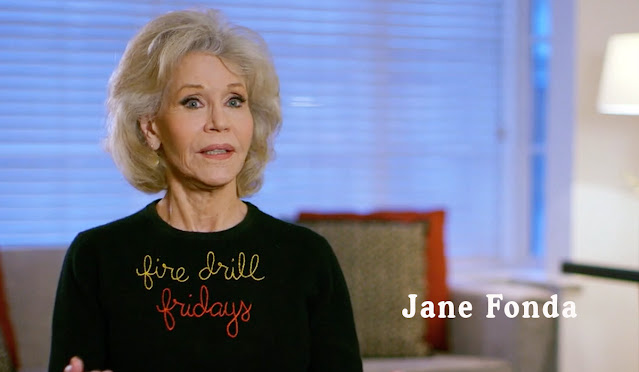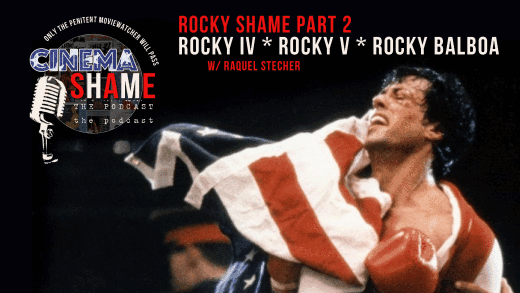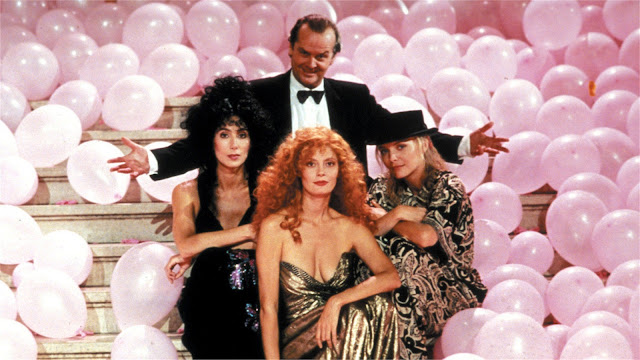 |
| Lillian Gish and Bette Davis in The Whales of August (1987) |
"Passion and truth -- that's all we need." - Sarah
Sometimes you need strong voices to tell a quiet story.
Actresses
Lillian Gish and
Bette Davis were two forces to be reckoned with in the film industry. Gish and Davis helped usher the medium in its earliest days and broke down misconceptions of what actresses were capable of. Throughout their many decades in the business, the two had never worked together and remarkably hadn't even crossed paths. It wasn't until 1986 when they would come together to make the swan song of their respective careers:
The Whales of August (1987). It would be the final completed film roles for both actresses (Davis appeared in one more film but did not finish her part).
Set on an island off the coast of Maine circa the mid-1950s,
The Whales of August is a gentle tale of two elderly sisters, Sarah Webber (Lillian Gish) and Libby Strong (Bette Davis), vacationing in their summer home. Both widowed, Sarah tends to Libby who is now blind. The two sisters couldn't be more different from each other. Sarah is an optimistic and gentle soul who enjoys the small things in life and the company of good people. She especially loves the romantic attention she gets from the handsome and recently widowed Mr. Maranov (
Vincent Price), whose pension for old customs charms her. Libby has grown bitter in her old age and senses death is just around the corner. She chides Sarah and others for insignificant things because she's not capable of letting herself be happy in her current state. Their lifelong friend Tisha (
Ann Sothern) often stops by to gossip with the ladies and offer some unsolicited advice. Local handyman Joshua Brackett (
Harry Carey Jr.), who is a little too loud for his own good, also stops by to help the sisters tend to their beautiful cliff side home. We follow these five souls over a few days in August, the one month out of the year when you can see the whales from the coast line.
 |
| Ann Sothern and Vincent Price in The Whales of August (1987) |
As a lifelong New Englander, I've always been drawn to quiet stories like these. Simple tales about simple lives are sometimes the most potent. When you strip down everything down to its essentials and you focus on the emotional lives of people there is much to uncover. Everything is felt much more acutely because the events in your life aren't fighting with a lot of other stimuli for attention. As a teenager in the throes of the angst of my own simple life, I was drawn to the stories of Louisa May Alcott, Henry James, Thomas Hardy and Jane Austen and would have been enthralled by
The Whales of August. It would have spoken to me in a more profound way. Today I live a busy and stressful life and sometimes long for a simpler existence and I get in touch with my past with movies like this.
The Whales of August came out at a time when home video had reinvigorated interest in both classic film and the many aging stars who were still with us. Films like
On Golden Pond (1981) and
Cocoon (1985) were showcasing older stars in lead roles. Producer Mike Kaplan, who had worked with Lillian Gish on the set of
The Comedians (1967), wanted to find a starring role suitable for the elderly actress. Kaplan attended the off Broadway premiere of David Berry's play
The Whales of August in Rhode Island and immediately thought this was the perfect story not only for Lillian Gish but for Bette Davis as well. Davis turned down the role of Libby Strong and so did Katharine Hepburn and Barbara Stanwyck. Davis had been sick after a stroke and a mastectomy when she was strong enough again she became interested in the role and it was hers.
For the role of Mr. Maranov, John Gieguld was on board but due to a scheduling conflict he had to bow out and was replaced by Vincent Price. For the part of Tisha, Kaplan was reluctant to hire Ann Sothern who had become partly immobile due to a stage accident. Sothern won him over and uses a cane to get around in the film. The part seemed destined to be hers considering she named her own daughter Tisha. In fact, Tisha Sterling appears in the film as the younger version of the role her mother plays. Price will simultaneously charm you and break your heart. He brings a gentleness and old school charisma to the part.
Lillian Gish's Sarah and Bette Davis' Libby were roles that seemed custom made for the two actresses. Gish was adept at playing parts of women who were gentle in nature yet strong in spirit. In an interview during the filming of the movie Davis claimed that she had no connection whatsoever with Libby and that it was just a part. But one can see that an older Davis was very much like Libby cantankerous, feisty yet vulnerable. It's marvelous to watch both of these legends so effortlessly play these parts not just because it suited them but because of what they could convey. Ann Sothern's Tisha is the quintessential small town socialite. She received an Academy Award nomination for her role and it ended up being her final film.
This film was never going to be a blockbuster. A story about isolation, loneliness, growing old in a small community isn't going to draw many to the cinema. Instead,
The Whales of August was a passion project for Kaplan, director Lindsay Anderson and writer David Berry. The ending of the play was changed for the movie per director Lindsay Anderson's request and to make the film more receptive to movie audiences. It was also an opportunity for legendary actresses Gish and Davis to once again play leading roles. For Vincent Price, who hadn't been working on much for a while, it was an opportunity to do something different. In an interview he said, "I felt the things I was being offered were already done." Price admired the writing, the dialogue and the heart of the play. He went on to say, "Maine is basic America." The setting itself is its own character. The film was shot on location at the Pitkin house on Cliff Island near Portland, Maine.
Filmed in September and October of 1986, Lillian Gish was 93, Bette Davis 78, Vincent Price 75, Ann Sothern 77 and Harry Carey Jr. 65. This is an opportunity to watch five legends who had vastly different careers come together in one beautiful movie.
If you've ever been hesitant about watching this film, whether it's a fear of exploring the complexities of growing old or seeing your favorites in such an advanced state.
The Whales of August is a compelling movie with a lot of heart and reassures us that there is a good life to be led even at the end of our time here on earth.
The Whales of August (1987) was recently released on Blu-Ray and DVD from Kino Lorber. This edition comes packed with extras. I particularly liked the 1 hour and 12 minute piece that includes on set interviews with the five main players Price, Gish, Sothern, Carey and Davis in that order. Davis' interview is difficult to watch because she gave the poor interviewer such a hard time. Other extras include on set interviews withLindsay Anderson, Mike Fash, Jocelyn Herbert, other interviews with Mike Kaplan, Mary Steenburgen, Margaret Ladd and Tisha Sterling, as well as audio commentary with film critic. The Blu-Ray quality
Many thanks to Kino Lorber for sending me the Blu-Ray of
The Whales of August for review!




















































